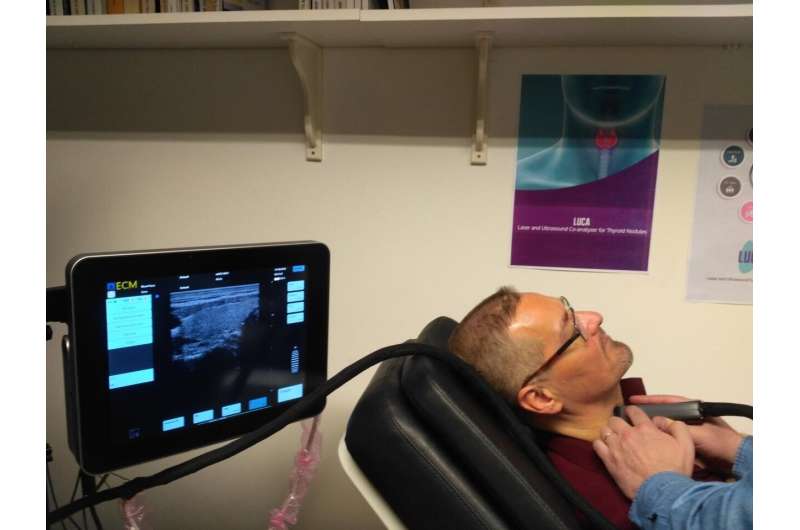LUCA device proves its readiness for better thyroid cancer screening

Thyroid nodules are a common pathology having a prevalence of 19-76% when screened with ultrasound, with higher frequencies in women. Current medical methods used to assess the malignancy of a nodule consist in performing an ultrasound, followed by a Doppler ultrasound, and then a biopsy. However, these methods present both low specificity and low sensitivity. This insufficient effectiveness in accurately being able to diagnose thyroid tumors leads to many unclear or unnoticed cases as well as many others that undergo unnecessary surgeries (false positives) and increase the cost of medical healthcare, not to mention the reduction of quality of life of patients.
The EU-funded project Laser and Ultrasound Co-analyzer for Thyroid Nodules (LUCA) started in 2016 and over its 5 years of duration, it worked on the development of a new low-cost near-infrared optical device combined with ultrasound that searched to provide doctors with enhanced information required to provide better and more specific results in thyroid nodule screening. The goal of such a device was mainly to enable a better diagnosis of this type of cancer because so far, there was no accurate way of determining whether a thyroid tumor as benign or malignant.
The LUCA device is a multi-modal platform combining near infrared light, time resolved spectroscopy (TRS), diffuse correlation spectroscopy (DCS), and ultrasound in one single device.
Clinical testing with LUCA
The study recently published in Biomedical Optics Express and authored by members of the consortium reports on several study cases and clinical tests conducted to validate the accuracy and high quality of measurements achieved by the LUCA device.
As a first step, the TRS and DCS modules were tested independently using phantom1 tests to validate the performance of both under the different European medical standardization protocols. For the former module, a set of solid phantoms with different absorptions and scatterings was used to assess the capability of the device to detect absorption and scattering changes, while for the latter, a set of liquid phantoms with different viscosities was used to assess the capability of the device of measuring the movement of the particles in suspension in the liquid phantom. The tests performed did prove to be successful, validating the outstanding performances of both modules.
Then, as a second step, the team of experts performed a series of in vivo characterization tests on a model healthy patient. By scanning the thyroid gland, simultaneously with ultrasound imaging, TRS and DCS, several times a day in different days and different weeks, they were to determine the precision of the LUCA device in measuring the hemodynamic parameters related to the thyroid gland.
Recently, the device has been moved into the clinical environment and tested on 18 healthy volunteers and 47 patients diagnosed with thyroid nodules and scheduled for thyroidectomy. The LUCA device showed potential for identifying the group of nodules as benign or malignant, which were stipulated as unclear cases with the classical ultrasound screening technique. By analyzing the metabolic rate of oxygen consumption and total hemoglobin concentration, the device was able to classify thirteen benign and four malignant nodules with a sensitivity of 100% and specificity of 77%.
Dr. Mireia Mora from the August Pi i Sunyer Biomedical Research Institute (IDIBAPS) in Barcelona, Spain, which is responsible for the clinical application of the tool, under the direction of Prof. Ramon Gomis, highlights the fact that "The need to improve the current standards of thyroid cancer diagnosis has driven us to participate in this multidisciplinary project. We have taken the first steps in preclinical testing, but are sure that with this technology we will be able to avoid unnecessary surgeries and thus improve the quality of life of our patients."
Dr. Turgut Durduran, coordinator of the LUCA project, group leader at ICFO of the Medical Optics research group, commented that "this project has allowed us to develop a unique optical-ultrasound platform that we are confident that will find a use in the clinical thyroid cancer screening." Recent advances of diffuse optical techniques have shown that not only these techniques have a tremendous potential in this field, but other fields as well, such as breast, head and neck cancer, abdominal cancer screening and therapy monitoring, cerebrovascular accidents (ictus) or even for COVID19, to name a few. Durduran finally remarks, "We have learnt a lot and are anxious to continue working in this line of research because we believe that this technique could substantially improve the quality of measurements, narrow down diagnosis and helps asses in possible treatments of patients."
Diffuse optics to improve medical diagnosis and treatment
Near infrared diffuse optical spectroscopy is an optical method that provides significant complementary information to other medical techniques used for imaging, such as ultrasounds. The LUCA device incorporates two different diffuse optical spectroscopy technologies (TRS and DCS) to improve the screening of thyroid nodules for cancer. These techniques have made it a completely novel device, because it is non-invasive and safe to use, portable, low cost, it probes deep enough into the tissue (>1cm deep) to give substantial information about the surrounding tissue, in this case the thyroid, and it provides a real-time monitoring evaluation together with the ultrasound counterpart.
The TRS and DCS modules consist of custom-made components, such as laser heads and off-the-shelf-electronics for detectors and acquisition electronics, which makes them cheaper than any other commercially available TRS and DCS devices.
Despite being low cost, the custom developed components enhance performance features allowing the LUCA device to obtain high quality measurements of the tissue's hemodynamics (blood flow and oxygen at the microvascular level), chemical constitution (water and lipids concentration) as well as anatomy.
More information: Lorenzo Cortese et al, The LUCA device: a multi-modal platform combining diffuse optics and ultrasound imaging for thyroid cancer screening, Biomedical Optics Express (2021). DOI: 10.1364/BOE.416561


















